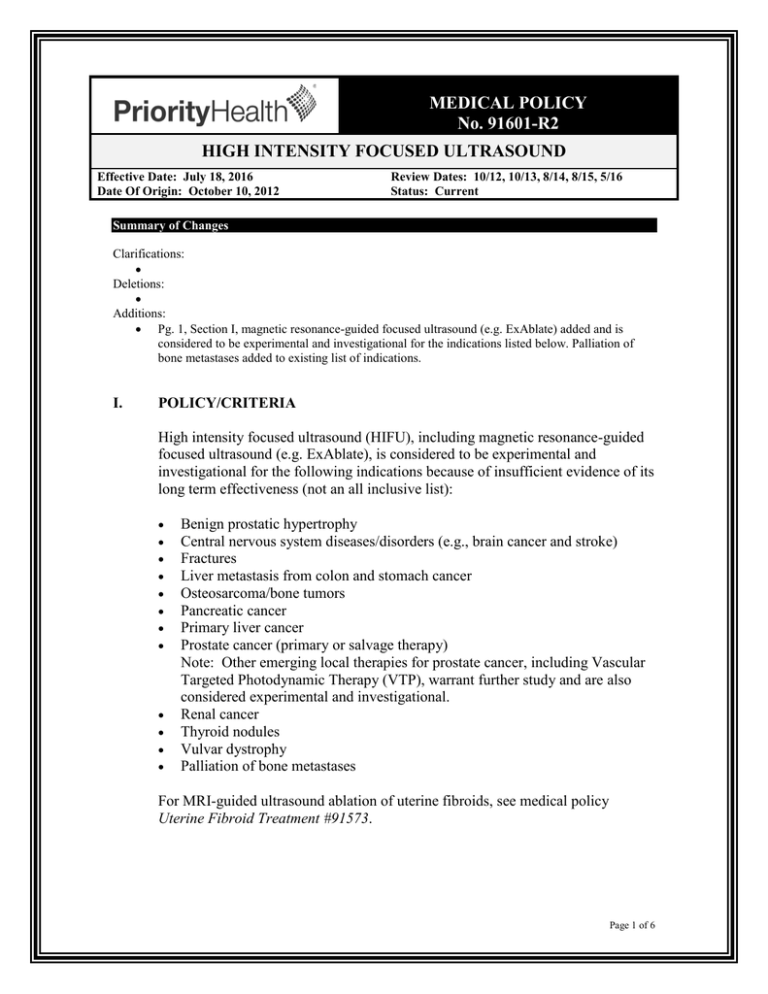
MEDICAL POLICY
No. 91601-R2
HIGH INTENSITY FOCUSED ULTRASOUND
Effective Date: July 18, 2016
Date Of Origin: October 10, 2012
Review Dates: 10/12, 10/13, 8/14, 8/15, 5/16
Status: Current
Summary of Changes
Clarifications:
•
Deletions:
•
Additions:
• Pg. 1, Section I, magnetic resonance-guided focused ultrasound (e.g. ExAblate) added and is
considered to be experimental and investigational for the indications listed below. Palliation of
bone metastases added to existing list of indications.
I.
POLICY/CRITERIA
High intensity focused ultrasound (HIFU), including magnetic resonance-guided
focused ultrasound (e.g. ExAblate), is considered to be experimental and
investigational for the following indications because of insufficient evidence of its
long term effectiveness (not an all inclusive list):
•
•
•
•
•
•
•
•
•
•
•
•
Benign prostatic hypertrophy
Central nervous system diseases/disorders (e.g., brain cancer and stroke)
Fractures
Liver metastasis from colon and stomach cancer
Osteosarcoma/bone tumors
Pancreatic cancer
Primary liver cancer
Prostate cancer (primary or salvage therapy)
Note: Other emerging local therapies for prostate cancer, including Vascular
Targeted Photodynamic Therapy (VTP), warrant further study and are also
considered experimental and investigational.
Renal cancer
Thyroid nodules
Vulvar dystrophy
Palliation of bone metastases
For MRI-guided ultrasound ablation of uterine fibroids, see medical policy
Uterine Fibroid Treatment #91573.
Page 1 of 6
MEDICAL POLICY
No. 91601-R2
II.
MEDICAL NECESSITY REVIEW
Required
III.
High Intensity
Focused Ultrasound
Not Required
Not Applicable
APPLICATION TO PRODUCTS
Coverage is subject to member’s specific benefits. Group specific policy will
supersede this policy when applicable.
HMO/EPO: This policy applies to insured HMO/EPO plans.
POS: This policy applies to insured POS plans.
PPO: This policy applies to insured PPO plans. Consult individual plan documents as
state mandated benefits may apply. If there is a conflict between this policy and a plan
document, the provisions of the plan document will govern.
ASO: For self-funded plans, consult individual plan documents. If there is a conflict
between this policy and a self-funded plan document, the provisions of the plan document
will govern.
INDIVIDUAL: For individual policies, consult the individual insurance policy. If there is
a conflict between this medical policy and the individual insurance policy document, the
provisions of the individual insurance policy will govern.
MEDICARE: Coverage is determined by the Centers for Medicare and Medicaid Services
(CMS); if a coverage determination has not been adopted by CMS, this policy applies.
MEDICAID/HEALTHY MICHIGAN PLAN: For Medicaid/Healthy Michigan Plan
members, this policy will apply. Coverage is based on medical necessity criteria being met
and the appropriate code(s) from the coding section of this policy being included on the
Michigan Medicaid Fee Schedule located at: http://www.michigan.gov/mdch/0,1607,7132-2945_42542_42543_42546_42551-159815--,00.html. If there is a discrepancy between
this policy and the Michigan Medicaid Provider Manual located
at: http://www.michigan.gov/mdch/0,1607,7-132-2945_5100-87572--,00.html, the
Michigan Medicaid Provider Manual will govern. For Medical Supplies/DME/Prosthetics
and Orthotics, please refer to the Michigan Medicaid Fee Schedule to verify coverage.
IV.
DESCRIPTION
High-intensity focused ultrasound (HIFU) uses externally generated sonic waves
to create a sharply delineated area of thermal energy that destroys the target
tissue. The role of ablation with HIFU as an alternative to radical prostatectomy
or RT remains uncertain.
National Comprehensive Cancer Network ® (NCCN®): The 2012 NCCN
Clinical Practice Guidelines in Oncology Prostate Cancer does not include HIFU
among the therapeutic options for localized prostate cancer.
American Urological Association (AUA): The AUA Guideline for the
Management of Clinically Localized Prostate Cancer reports that standard options
for the management of clinically localized prostate cancer include watchful
waiting and active surveillance, interstitial prostate brachytherapy, external beam
Page 2 of 6
MEDICAL POLICY
No. 91601-R2
High Intensity
Focused Ultrasound
radiotherapy, radical prostatectomy, as well as primary hormonal therapy. The
panel did not include other treatment options in the analysis and recommendations
due to a combination of factors, including limited published experience and shortterm follow-up as well as the similar issues that affected evaluations of other
treatment options (Thompson, et al., 2007). This guideline was reviewed and the
validity confirmed in 2011.
American College of Radiology (ACR) Appropriateness Criteria®: The 2011
American College of Radiology Expert Panel on Radiation Oncology-Prostate
Work Group's guideline on locally advanced (high-risk) prostate cancer does not
mention the use of HIFU in the list of treatment options. The summary states that
HIFU is currently an experimental therapy.
American Cancer Society (ACS): HIFU is mentioned as a newer treatment for
early stage prostate cancer. The ACS states that new treatments could be used
either as the first type of treatment or after radiation therapy in cases where it was
not successful. HIFU treatment has been used more in Europe, but it is not
available outside of clinical trials in the United States at this time. Studies are now
under way to determine its safety and effectiveness (ACS, 2012).
National Cancer Institute (NCI): HIFU is not discussed in the 2012 Prostate
Cancer Treatment health professional version Physician Data Query (PDQ). In the
2011 Prostate Cancer Treatment patient version Physician Data Query (PDQ)
HIFU is listed as a new type of treatment being tested in clinical trials.
V.
CODING INFORMATION
ICD-10 Diagnosis:
See criteria above.
CPT/HCPCS codes:
Not covered
C9734 Focused ultrasound ablation/therapeutic intervention, other than uterine
leiomyomata, with or without magnetic resonance (MR) guidance (OP facility
claims only)
27599
47399
48999
50549
55899
58999
60699
64999
Unlisted procedure, femur or knee
Unlisted procedure, liver
Unlisted procedure, pancreas
Unlisted laparoscopy procedure, renal
Unlisted procedure, male genital system [when specified as destruction of
prostate tissue by high intensity focused ultrasound]
Unlisted procedure, female genital system (nonobstetrical)
Unlisted procedure, endocrine system
Unlisted procedure, nervous system
Page 3 of 6
MEDICAL POLICY
No. 91601-R2
76999
VI.
High Intensity
Focused Ultrasound
Unlisted ultrasound procedure (eg, diagnostic, interventional) Explanatory notes must accompany claims billed with unlisted codes
REFERENCES
1. American Cancer Society (ACS). What’s new in prostate cancer research and
treatment? Last reviewed and revised Feb 12,
2012. http://www.cancer.org/Cancer/ProstateCancer/DetailedGuide/prostatecancer-new-research
2. American College of Radiology (ACR). ACR Appropriateness Criteria ®.
Locally advanced (high risk) prostate cancer. Date of origin 1996. Last review
date 2011. http://www.acr.org
3. Asimakopoulos AD, Miano R, Virgili G, Vespasiani G, Finazzi Agrò E. HIFU
as salvage first-line treatment for palpable, TRUS-evidenced, biopsy-proven
locally recurrent prostate cancer after radical prostatectomy: A pilot study.
Urol Oncol. 2011 Feb 1.
4. Aus G. Current status of HIFU and cryotherapy in prostate cancer--a review.
Eur Urol. 2006 Nov;50(5):927-34.
5. Blana A, Murat FJ, Walter B, Thuroff S, Wieland WF, Chaussy C, et al. First
Analysis of the Long-Term Results with Transrectal HIFU in Patients with
Localised Prostate Cancer. Eur Urol. 2007 Nov 5 [Epub ahead of print].
6. Blana A, Walter B, Rogenhofer S, Wieland WF. High-intensity focused
ultrasound for the treatment of localized prostate cancer: 5-year experience.
Urology. 2004 Feb;63(2):297-300.
7. Boutier R, Girouin N, Cheikh AB, Belot A, Rabilloud M, Gelet A, et al.
Location of residual cancer after transrectal high-intensity focused ultrasound
ablation for clinically localized prostate cancer. BJU Int. 2011
Dec;108(11):1776-81.
8. Catalona WJ, Han M. Definitive therapy for localized prostate cancer-an
overview. Wein: Campbell-Walsh Urology. 10th ed., Philadelphia, PA:
Saunders; 2011. Ch 100.
9. Chaussy CG, Thüroff S. Transrectal high-intensity focused ultrasound for
local treatment of prostate cancer: current role. Arch Esp Urol. 2011
Jul;64(6):493-506.
10. Crouzet S, Rebillard X, Chevallier D, Rischmann P, Pasticier G, Garcia G, et
al. Multicentric oncologic outcomes of high-intensity focused ultrasound for
localized prostate cancer in 803 patients. Eur Urol. 2010 Oct;58(4):559-66.
Epub 2010 Jul 3.
11. Dubinsky TJ, Cuevas C, Dighe MK, Kolokythas O, Hwang JH. High-intensity
focused ultrasound: current potential and oncologic applications. AJR Am J
Roentgenol. 2008 Jan;190(1):191-9.
12. ECRI Institute. Hotline Response [database online]. Plymouth Meeting (PA):
ECRI Institute; 2011 Nov 10. High-intensity Focused Ultrasound for Prostate
Cancer. Available at URL address: http://www.ecri.org
Page 4 of 6
MEDICAL POLICY
No. 91601-R2
High Intensity
Focused Ultrasound
13. El Fegoun AB, Barret E, Prapotnich D, Soon S, Cathelineau X, Rozet F, et al.
Focal therapy with high-intensity focused ultrasound for prostate cancer in the
elderly. A feasibility study with 10 years follow-up. Int Braz J Urol. 2011
Mar-Apr;37(2):213-9; discussion 220-2.
14. Fujisue Y, Azuma H, Inamoto T, Komura K, Agarwal PK, Masuda H, et al.
Neoadjuvant hormonal therapy does not impact the treatment success of highintensity focused ultrasound for the treatment of localized prostate cancer.
World J Urol. 2011 Oct;29(5):689-94. Epub 2010 Dec
15. Ganzer R, Robertson CN, Ward JF, Brown SC, Conti GN, Murat FJ, et al.
Correlation of prostate-specific antigen nadir and biochemical failure after
high-intensity focused ultrasound of localized prostate cancer based on the
Stuttgart failure criteria - analysis from the @-Registry. BJU Int. 2011; 108(8
Pt 2):E196-201.
16. Hummel S, Paisley S, Morgan A, Currie E, Brewer N. Clinical and costeffectiveness of new and emerging technologies for early localised prostate
cancer: a systematic review. Health Technol Assess. 2003;7(33):iii, ix-x, 1157.
17. Inoue Y, Goto K, Hayashi T, Hayashi M. Transrectal high-intensity focused
ultrasound for treatment of localized prostate cancer. Int J Urol. 2011
May;18(5):358-62.
18. Koch MO, Gardner T, Cheng L, Fedewa RJ, Seip R, Sanghvi NT. Phase I/II
trial of high intensity focused ultrasound for the treatment of previously
untreated localized prostate cancer. J Urol. 2007 Dec;178(6):2366-70;
discussion 2370-1.
19. Koch MO. High intensity focused ultrasound treatment for prostate cancer.
Wein: Campbell-Walsh Urology. 10th ed. W. B. Saunders. Philadelphia, PA;
2011.
20. Lawrentschuk N, Finelli A, Van der Kwast TH, Ryan P, Bolton DM, Fleshner
NE, et al. Salvage radical prostatectomy following primary high intensity
focused ultrasound for treatment of prostate cancer. J Urol. 2011
Mar;185(3):862-8. Epub 2011 Jan 15.
21. Lukka H, Waldron T, Chin J, Mayhew L, Warde P, Winquist E, et al. Highintensity focused ultrasound for prostate cancer: a practice guideline. Can
Urol Assoc J. 2010 Aug;4(4):232-6.
22. Lukka H, Waldron T, Chin J, Mayhew L, Warde P, Winquist E, et al.;
Genitourinary Cancer Disease Site Group of Cancer Care Ontario's Program
in Evidence-Based Care. High-intensity focused ultrasound for prostate
cancer: a systematic review. Clin Oncol (R Coll Radiol). 2011 Mar;23(2):11727. Epub 2010 Oct 6.
23. Misraï V, Rouprêt M, Chartier-Kastler E, Comperat E, Renard-Penna R,
Haertig A, et al. Oncologic control provided by HIFU therapy as single
treatment in men with clinically localized prostate cancer. World J Urol. 2008
Oct;26(5):481-5.
Page 5 of 6
MEDICAL POLICY
No. 91601-R2
High Intensity
Focused Ultrasound
24. Muto S, Yoshii T, Saito K, Kamiyama Y, Ide H, Horie S. Focal therapy with
high-intensity-focused ultrasound in the treatment of localized prostate cancer.
Jpn J Clin Oncol. 2008 Mar;38(3):192-9.
25. National Cancer Institute (NCI). Prostate Cancer (PDQ®): Treatment. Patient
Version. Modified Nov 10, 2011. Accessed April 30, 2012. Available at URL
address: http://www.cancer.gov/cancertopics/pdq/treatment/prostate/Patient
26. National Cancer Institute (NCI). Prostate Cancer (PDQ®): Treatment. Health
Professional Version. Modified Jan 20, 2012. Accessed April 30, 2012.
Available at URL address:
http://www.cancer.gov/cancertopics/pdq/treatment/prostate/HealthProfessiona
l/page4
27. National Comprehensive Cancer Network® (NCCN). NCCN
GUIDELINES™ Clinical Guidelines in Oncology™. © National
Comprehensive Cancer Network, Inc 2012, All Rights Reserved. Prostate
cancer v.3. 2012. Accessed May 2, 2012, & June 21, 2015. Available at URL
address: http://www.nccn.org/professionals/physician_gls/f_guidelines.asp
28. High Intensity Focused Ultrasound, Aetna Clinical Policy Bulletin
@ http://www.aetna.com/cpb/medical/data/700_799/0766.html (Retrieved
June 18, 2015)
29. Eur Urol. 2013 Apr;63(4):618-22. doi: 10.1016/j.eururo.2012.11.057. Epub
2012 Dec Morbidity of focal therapy in the treatment of localized prostate
cancer.Barret E1, Ahallal Y, Sanchez-Salas R, Galiano M, Cosset JM, Validire
P, Macek P, Durand M, Prapotnich D, Rozet F, Cathelineau X.
30. Hayes, Inc. Magnetic Resonance–Guided Focused Ultrasound Therapy
(ExAblate; InSightec Ltd.) for Palliation of Painful Bone Metastases, March
3, 2016
AMA CPT Copyright Statement:
All Current Procedure Terminology (CPT) codes, descriptions, and other data are copyrighted by the
American Medical Association.
This document is for informational purposes only. It is not an authorization, certification, explanation of
benefits, or contract. Receipt of benefits is subject to satisfaction of all terms and conditions of coverage.
Eligibility and benefit coverage are determined in accordance with the terms of the member’s plan in effect
as of the date services are rendered. Priority Health’s medical policies are developed with the assistance
of medical professionals and are based upon a review of published and unpublished information including,
but not limited to, current medical literature, guidelines published by public health and health research
agencies, and community medical practices in the treatment and diagnosis of disease. Because medical
practice, information, and technology are constantly changing, Priority Health reserves the right to review
and update its medical policies at its discretion.
Priority Health’s medical policies are intended to serve as a resource to the plan. They are not intended to
limit the plan’s ability to interpret plan language as deemed appropriate. Physicians and other providers
are solely responsible for all aspects of medical care and treatment, including the type, quality, and levels
of care and treatment they choose to provide.
The name “Priority Health” and the term “plan” mean Priority Health, Priority Health Managed Benefits,
Inc., Priority Health Insurance Company and Priority Health Government Programs, Inc.
Page 6 of 6


